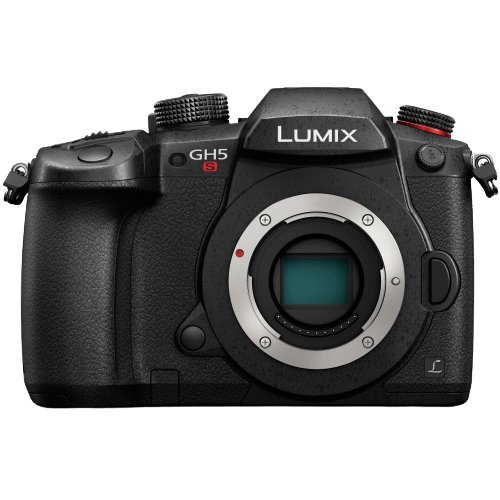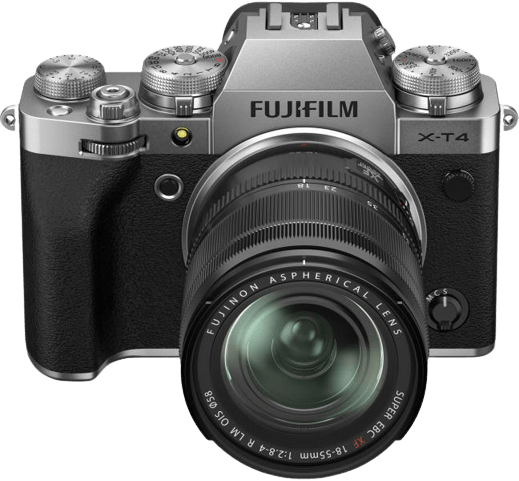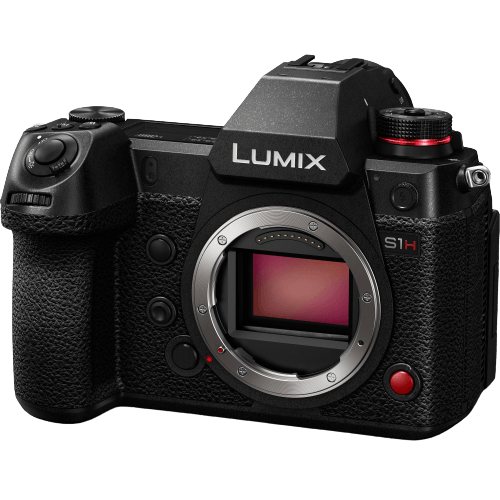We’ve gathered together our top picks for you, for a range of budgets. Our top pick is the Panasonic Lumix GH5S. It has incredible autofocus, external sound ports, and focus racking via its touchscreen. [Note: ExpertPhotography is supported by readers. Product links on ExpertPhotography are referral links. If you use one of these and buy something, we make a little bit of money. Need more info? See how it all works here.]
What Are the Best Mirrorless Cameras for Video?
There’s something here for nearly every budget. Before we dive into details about each camera, here’s a summary of our recommendations. So let’s take a look at the best mirrorless cameras to use for video. There is no doubt that the Lumix DMC-GH5S is one of the most video-oriented mirrorless cameras on the market. That’s why it’s our top choice. This means that it dedicates itself to producing high-quality video output. It has a head-spinning range of video shooting modes that top out in 4K at 400 Mbps, and send a 10-bit signal both to its internal storage and HDMI output. It seems almost impossible to defeat the GH5S’ sophisticated autofocus. As well as allowing you to select focus points via the touchscreen, you can use the Focus Transition function. This allows smooth, pre-determined focus racking in a shot. External microphone and headphone sockets add to the impressive specifications list. The Lumix GH5S is a traditional DSLR-style body with a nice chunky grip for the right hand. Large dials and clear, well-spaced buttons help its usability. Its autofocus and video capabilities put it at the top of many a would-be videographer’s list. Panasonic has a well-deserved reputation for producing high-quality cameras. The Lumix DMC-GX85 is no exception. It has an impressive array of features at this price point, and the image stabilization is noteworthy. As with many Lumix cameras, the DMC-GX85 offers dual image stabilization. Used with Panasonic lenses, the 5-axis stabilization and the lens IS work in tandem. Panasonic lenses also increase the functionality of the AF. They use performance data from the lens to inform decisions made by the Depth from Defocus (DFD) AF system. There are 49 focus points in the Contrast Detect system and customizable face detection. This straightforward use of the touchscreen also helps focus racking. If you’re happy with 1080p video, you can even use the 4K Live Cropping feature. This lets you pan or zoom in on a shot without the camera moving or focal length changing. Another noteworthy feature is that you can customize the on-screen buttons according to your desires. This means you can access functions while filming without taking your eyes off the screen. SD card recording and Wi-Fi connectivity take care of recording and file transfer. And you can record video at up to 4K at 100 Mbps. The DMC-GX85 is one of the best mirrorless cameras for video available at this price level. It offers simplicity to match your smartphone, with a considerable step up in terms of flexibility and performance. Some features we’d like to see would be a fully-articulating screen (this only tilts up and down) and an external microphone socket. One big plus for the Lumix DMC-G7 is the external microphone port. In many circumstances, an external microphone can be a game-changer. Put simply, decent sound is impossible without an external microphone. Perhaps the most impressive feature of the Sony Alpha a6400 is its autofocus capabilities. It relies on Contrast Detect and Phase Detect processes and has 425 focus points. It delivers superb tracking performance of faces and eyes. And it’s easy to select tracking and focus from the touchscreen. While on the subject of the touchscreen, although it’s not fully articulating, the screen does tilt 180 degrees. This means you can see it above the camera body from the front. It’s more limited than a fully-articulating screen, but less prone to damage. And it’s better than a screen that only tilts. Image stabilization is lens-only, which is a little surprising given what the competition is doing. The external microphone socket is a bonus, but there is no headphone socket. Connectivity is a mixed bag—a good range of Wi-Fi, Bluetooth, and smartphone control. But only a UHS-I compliant SD card slot. The rock-solid autofocus might be the thing that sways you. After all, there’s not much point in being able to record images faster if they’re all out of focus. Although the Sony E lens mount is proprietary, there are third-party lenses. And if you can afford it, there are high-end full frame lenses that fit. Remember, though, that with FF lenses, there will be a crop factor of 1.5 when used on the a6400. There’s no mistaking where the design team took their cues from when they sketched out the Fujifilm X-T4. This looks like an old manual SLR, especially in its black faux leatherette and silver guise. I happen to think this camera looks superb. It’s not all about the looks, either. The Fujifilm X-T4 has a magnesium alloy body for strength and lightness and is a very capable performer as a mirrorless video camera. In-camera image stabilization is generally reliable, and CIPA rated to 6.5 stops. Autofocus has face tracking with 425 focus points. It is a Contrast Detect and Phase Detect system that seems to work especially well for video recording. Tracking is not always reliable in the most demanding situations, and this is perhaps a negative in terms of video recording. However, it offers a range of frame rates providing up to 400 Mbps in 4K mode. One final consideration is the lens mount. Fujifilm’s X-mount has a smaller range of OEM and third-party lenses available. Unlike other options, adapters for this mount will not provide fully automatic operation. Reliability, possibly unexciting performance, and rugged good looks sum up this X-T4 model from Fujifilm. The Nikon Z6 II looks every inch like a serious camera. The body is well-constructed and will feel familiar to anyone used to a DSLR. Surprisingly, the touchscreen LCD only tilts, so it won’t suit if you want to be in front of and behind the camera at the same time. Nikon uses a 5-axis in-body image stabilization system in the Z6II, which adds up to 5 stops. There is no coordinated in-body and lens IS. Video autofocus is robust and uses 273 focus points, incorporating Contrast Detect and Phase Detect. Face detection and tracking (with touchscreen selection) are there as you would expect. Also, it is no surprise that the Nikon Z6 II has both microphone and headphone sockets. Its solid overall performance is ideal for video and still photography. If your needs are fairly evenly balanced between the two, this is definitely a camera to consider. You’re not limited to Z-mount lenses. Adaptors for Nikon F-mount lenses provide a vast array of original and third-party lenses. It’s extraordinary that we have made it this far in the review before encountering first a Nikon and now a Canon camera. Both companies have tussled for the top spot as DSLR manufacturers for years. In the Canon EOS R6, we see a strong contender in the full frame sensor sector of the market for advanced mirrorless cameras. Perhaps one of the Canon EOS R6’s greatest strengths is the range of lenses available. The native RF lens mount is gaining numbers all the time, including some interesting “cine” style ones. Canon produces some of its prestigious and highly regarded “L-Series” lenses for the RF. This shows how seriously they take the future of mirrorless. Additionally, Canon’s own mount adaptors allow you to use your EF and even EF-S lenses. When using an EF-S lens, the EOS R6 automatically becomes an APS-C camera. The EOS R6 body is substantial and will feel familiar and comfortable to anyone used to shooting with one of the bigger DSLRs. The control placement is excellent, with a high degree of customization. Unlike many DSLRs, the controls here make sense when using the rear screen or the EVF. Image stabilization is solid, with body and lens stabilization combining to give up to 8 stops of improvement. Autofocus is based on a whopping 1053 focus points and uses phase detection. The EOS R6 has touch selection and tracking via the LCD screen as you would expect. The first thing you might notice from the quick specs above is the 6K video. At the moment, there aren’t many uses for 6K video. But capturing in full 6K gives you the flexibility to edit a 4K crop from a larger scene. This is just one of the benefits of the impressive video recording capabilities of the Lumix DC-S1H. It’s not the most expensive mirrorless camera, but it is a significant investment. So what does your money buy? Of course, there is in-camera image stabilization. Combining intelligently with the lens IS, it produces a 6.5-stop improvement. Autofocus is not always the best, but it offers touch focus selection, and face detection and tracking. There are 255 focus points. The Lumix DC-S1H is good to look at and a powerful contender for the best mirrorless camera for video. The Leica L lens mount has the additional attraction of an adapter to open up the field of Canon EF lenses.
What Features Make the Best Mirrorless Cameras for Video?
As well as being smaller than many DSLRs, mirrorless cameras are primarily designed around their LCD screens. You hold them in front of your body rather than pressed to your face. In most circumstances, this is better for video recording and is how you’ll shoot if you are using a stabilizer or gimbal.
What Sensor Size to Choose?
There are three sensor sizes relevant to this review of the best mirrorless cameras.
Full Frame
A full frame camera, equivalent to 35mm film, is necessarily bigger than one with a smaller sensor. They also have a reputation for producing the best image quality. This is partly because they can fit more pixels on their sensors and partly because those pixels have more space to “breathe.”
APS-C
The next size down is the APS-C sensor. This is the stock size for most entry-level DSLR cameras (and some quite sophisticated ones). Nikon, Pentax, Sony, Fujifilm, and others use a 370mm2 APS-C format, while Canon’s version is smaller at 329mm2.
Micro Four Thirds
Finally, we have the 225mm2 Micro Four Thirds sensor. Panasonic, Olympus, and Blackmagic use it in their cameras. The Micro Four Thirds sensor is only the size of old 110 film. But it is capable of producing impressive image and video quality. They are a world away from your memory of terrible pictures taken with a 110 compact camera.
What Body Style is Best?
A good number of our recommendations today are for mirrorless cameras that look like they have a DSLR. There is the familiar “lump” above the lens, and here is where you find the eyepiece. But instead of a glass screen, the image from the lens is shown in an electronic viewfinder (EVF). The advantage of this body style is probably most significant for those coming from the DSLR world. It will feel very familiar, and everything is where you expect it to be. Other cameras, like the Panasonic Lumix DC-S1H, offset the EVF, and you’ll find it at the top-left side of the body. This might take some getting used to, but it frees up the touchscreen LCD panel for Panasonic’s rather nifty interactive functions. You’re looking for the best mirrorless camera for video recording. So the chances are that you will be using the rear LCD screen for handheld shooting and not the EVF anyway.
What Lens Mount is Best?
The other major factor for consideration is the lens mount. We are evaluating cameras here with interchangeable lenses, and the mount should be a major consideration in your choice. Obviously, if you have a bag full of Canon lenses, this will probably affect your decision. There are also adapters for using mounts from one system on another. Where this is applicable, our recommendations will indicate this. Broadly speaking, the major old-school manufacturers like Nikon and Canon have their own stable of lenses. Micro Four Thirds is the unusual case here because it is not just a sensor size, but a lens mount system as well.
Is a Mirrorless Camera Right for You?
Although good-quality DSLRs can be used to shoot top-notch video, that’s not their main purpose. These mirrorless cameras almost beg to be used for shooting video. Many are also more than capable as still cameras. You’ll find we’ve included a quick appraisal of each camera’s photography capabilities. Mirrorless cameras offer flexibility and a wide choice of features by many manufacturers. All the cameras featured here have a menu system and stabilization to cope with camera shake. The trick is to identify your budget and prioritize your needs. Is it low-light performance over a body with built-in image stabilization, or is video quality more important than still images?
Conclusion
The search for the best mirrorless cameras for video can be bewildering. Panasonic alone produces enough mirrorless cameras to leave your head spinning. If you’re looking for a mirrorless camera that, above all else, will perform superbly with video, then the Panasonic Lumix DMC-GH5S is your best choice.











































